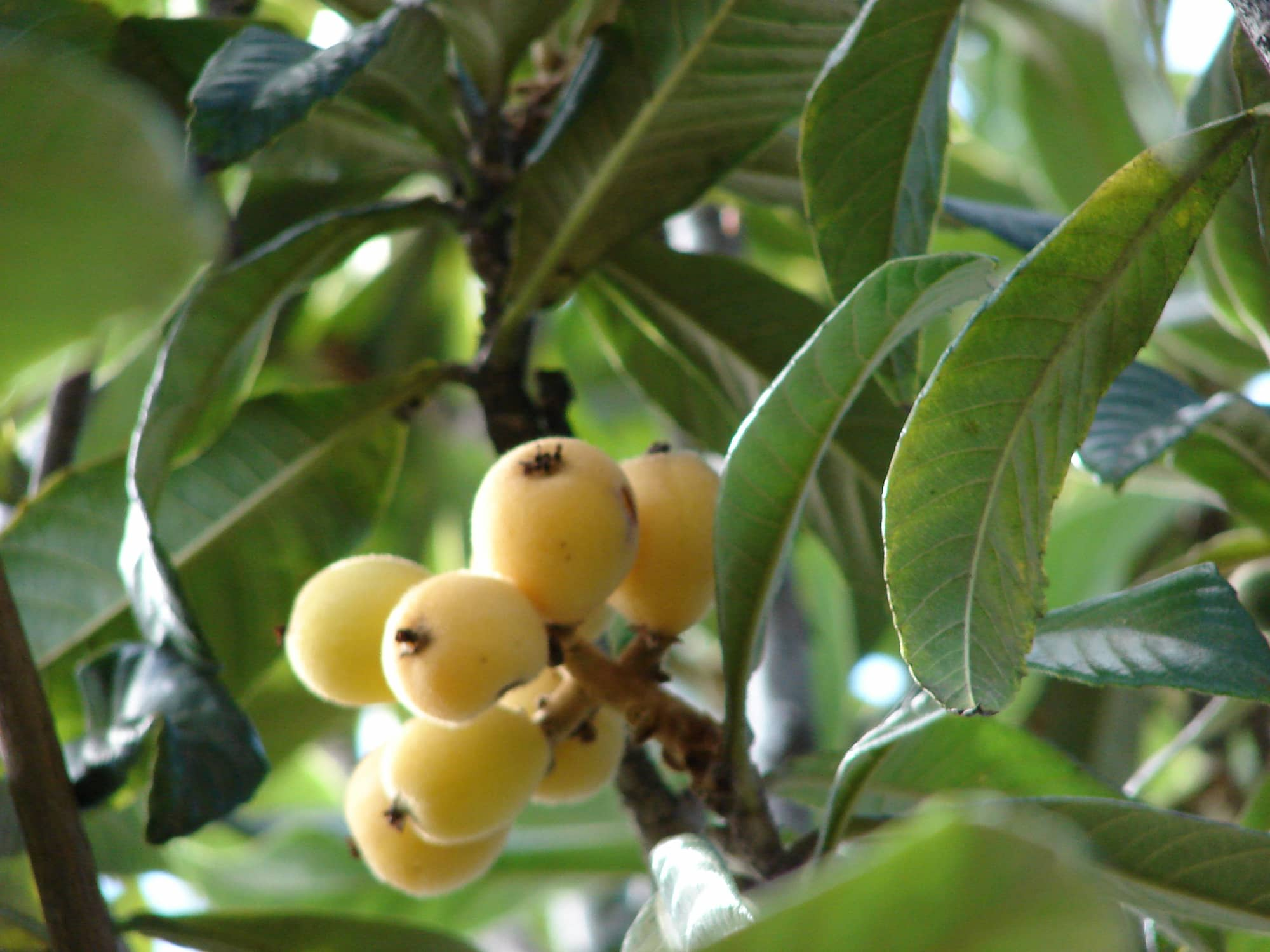
Japanese medlar: planting, growing, harvesting
Contents
Japanese medlar in a nutshell
- Its glossy leaves give it an exotic appearance
- It has a very fragrant and melliferous autumn flowering
- Its orange edible fruits, the size of an apricot, are juicy
- Hardy down to only -12 °C, it grows in open ground in the south of France
- It is drought-resistant
A word from our expert
Bien différent de notre néflier commun (Mespilus germanica), le Néflier du Japon (Eriobotrya japonica), également appelé bibacier (ou bibassier) ou loquat, est un petit arbre intéressant à plus d’un titre, à commencer par its appearance as a large exotic bush, thanks to its evergreen and glossy leaves, with very pronounced veins. This particular foliage makes it a highly ornamental bush, with a slightly tropical look.
One can also plant a Japanese loquat for its beautiful autumn flowering. Its cream-white flowers bloom in dense, trailing clusters. These flowers are a source of nectar for bees, which are responsible for its pollination.
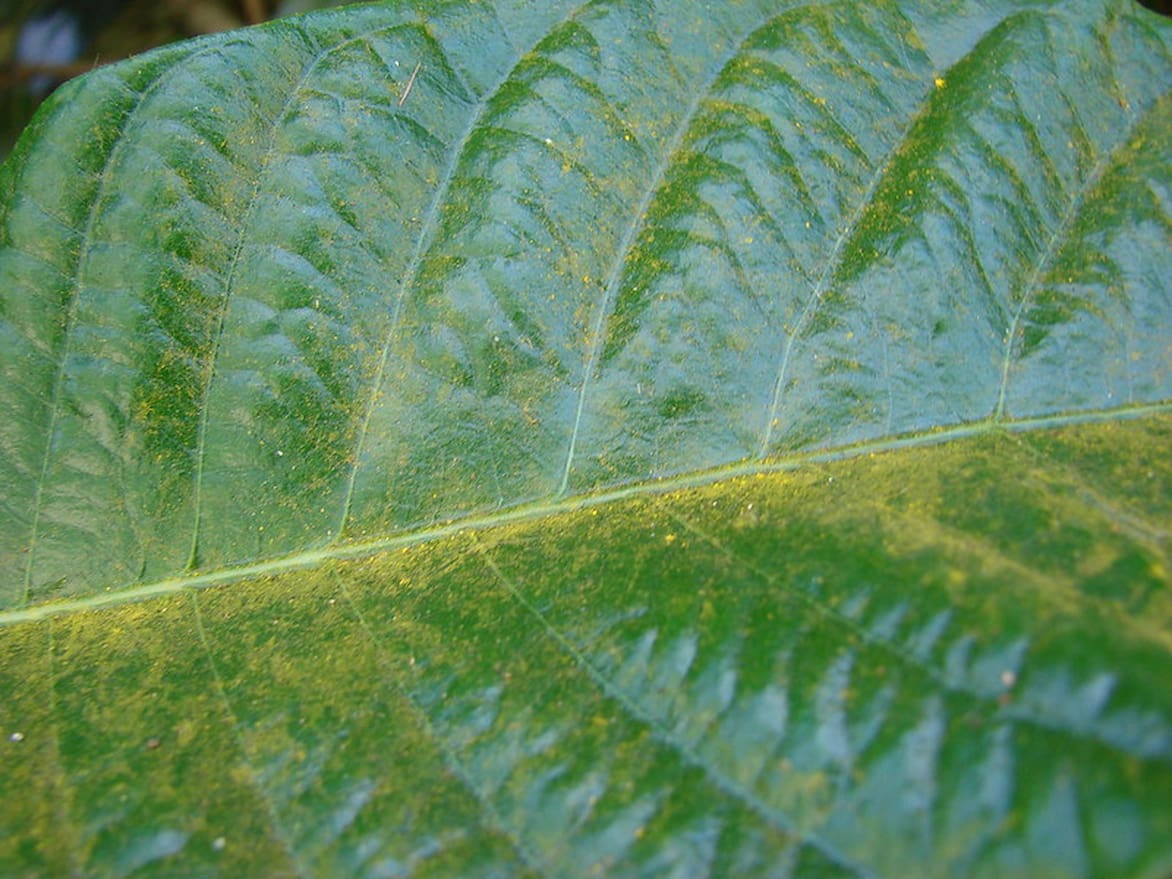
The foliage of the Japanese loquat is highly veined and glossy
Between May and June, orange fruits the size of apricots develop on the tree. Edible, these loquats have a taste that is both sweet and tangy, and especially very refreshing.
The Japanese loquat has an upright and spreading habit and can reach 6 metres in height with a spread of 4 to 5 metres.
Fast-growing, it prefers a location in full sun, sheltered from winds. Hardy down to -12 °C, it only fruits, when grown in the ground, in the south and southwest. Elsewhere, it grows well as an ornamental tree. It can also be cultivated in a pot. In the ground, it is perfect as a specimen or in a hedge.
Botany and description
Botanical data
- Latin name Eriobotrya japonica
- Family Rosaceae
- Common name Japanese loquat, bibacier (bibassier), Loquat
- Flowering autumn
- Height generally up to 6 metres
- Exposure full sun
- Soil type well-drained
- Hardiness down to -12 °C (but down to -5 °C for the flowers)
The Eriobotrya japonica belongs to the somewhat eclectic family of Rosaceae, alongside apple trees, plum trees, and cherry trees. Native to China, particularly the warm mountainous regions of Sichuan and Yunnan in the southwest, it has easily naturalised in Japan, introduced as early as the 11th century by a Buddhist monk. Today, the Japanese loquat grows in Europe, especially around the Mediterranean and in the southwest, as well as in Australia, California, and Florida, areas with a mild climate.
Nearly 1000 cultivars are recorded in China, Japan, and Spain. Besides Eriobotrya japonica, the type species, two varieties are distinguished: the Japanese loquats with early fruits that have white flesh and light yellow, rather thin skin, and the Chinese loquats, with later fruits characterised by orange flesh and thick skin. However, it is Eriobotrya japonica that remains the most cultivated in France. A Japanese loquat that is unrelated to the common medlar (Mespilus germanica), which is native to Northern Europe, thus much hardier, with deciduous foliage and produces medlar fruits. These small brown to dark brown fruits are consumed when over-ripe as they are very astringent.
The Japanese loquat benefits from rapid growth, allowing it to reach a height of 6 metres and a spread of 4 to 5 metres at maturity. Its upright habit quickly spreads to form a beautiful shade. Indeed, the crown of this large bush with a decidedly exotic appearance densifies rapidly to form a wide, ramified, slightly spreading crown. Some specimens form a single trunk, while others grow in coppice. A brown-grey bark covers the trunk(s).
Its foliage, quite dense, persists throughout the winter. It consists of large, leathery, lanceolate leaves with very visible, prominent veins and dentate edges. Measuring 15 to 25 cm long and 5 to 8 cm wide, the leaves are a well-defined, glossy green on top. Arranged in rosettes, they are wrinkled and rather oval in shape. A fine, slightly reddish down covers the underside of the leaves. As for the younger leaves, they are also covered with fine down but are more of an almond-green colour.
Flowering occurs between October and November, sometimes earlier or later in warmer climates. Some specimens may bloom as early as September, while others may continue until January. For about a month, floral bouquets consisting of clusters appear at the tips of the branches. These flower panicles, known as thyrses, are pyramid-shaped and droop slightly. They gather small flowers that are white to cream in colour and exude a sweet scent of bitter almond. Particularly melliferous, these flower clusters attract many pollinating insects, especially bees that find the nectar they feed on.
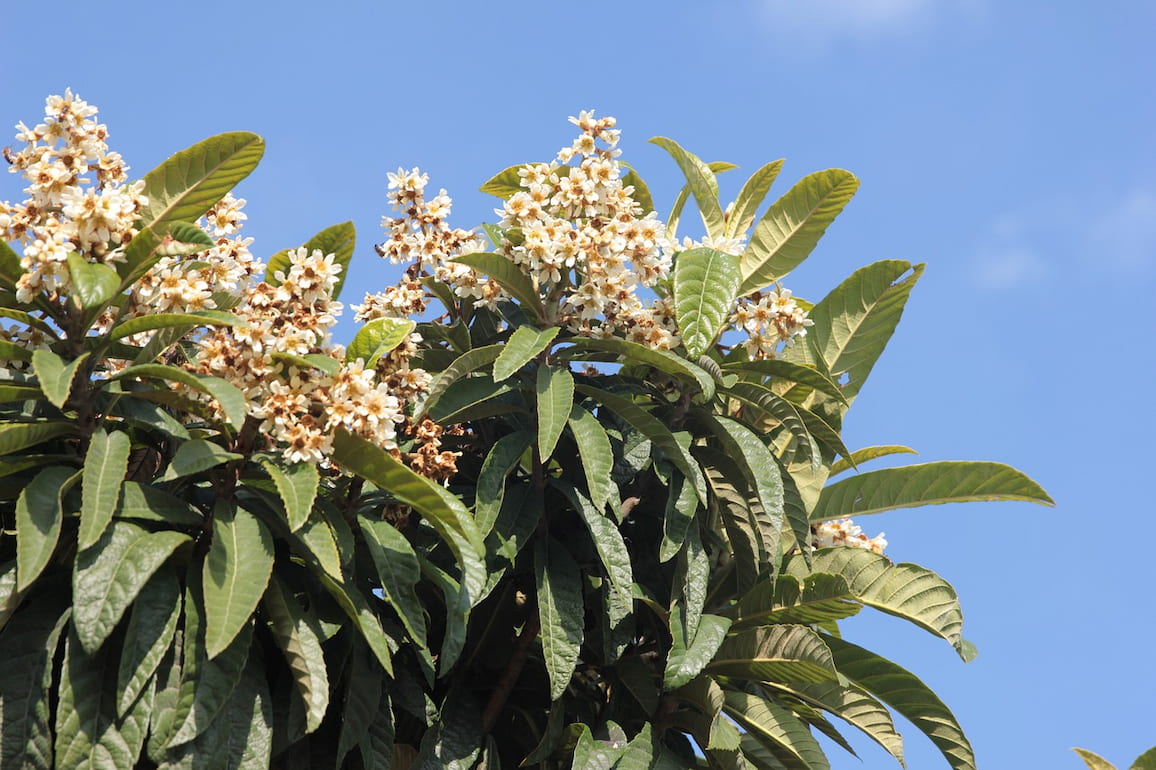
The Japanese loquat blooms in October-November
As the flowers bloom during a period that, in our latitudes, can be marked by frosts, they do not withstand temperatures of -3 to -5 °C. If the flowers freeze, fruiting will be compromised. It remains uncertain from year to year and is only effective during very mild winters.
Fruiting occurs in May-June, sometimes starting in April. The Japanese loquat produces fleshy fruits called bibasses or bibaces, whose size resembles that of an apricot or a plum. Oval or rounded in shape depending on the cultivars, these fruits measure about 3 cm and contain 1 to 4 shiny, inedible stones. Their juicy flesh is yellowish, even orange, relatively sweet with a hint of acidity. These are juicy fruits, very refreshing to eat as they are. However, their skin is very thin and does not withstand handling well. This is why bibasses should be enjoyed quickly after being picked.
These fruits are of great nutritional interest. Low in calories, they are rich in minerals, particularly magnesium, potassium, and calcium, as well as in fibre. They are consumed raw, well-ripened due to their tannin content, but also cooked, in compote, jam, or syrup.
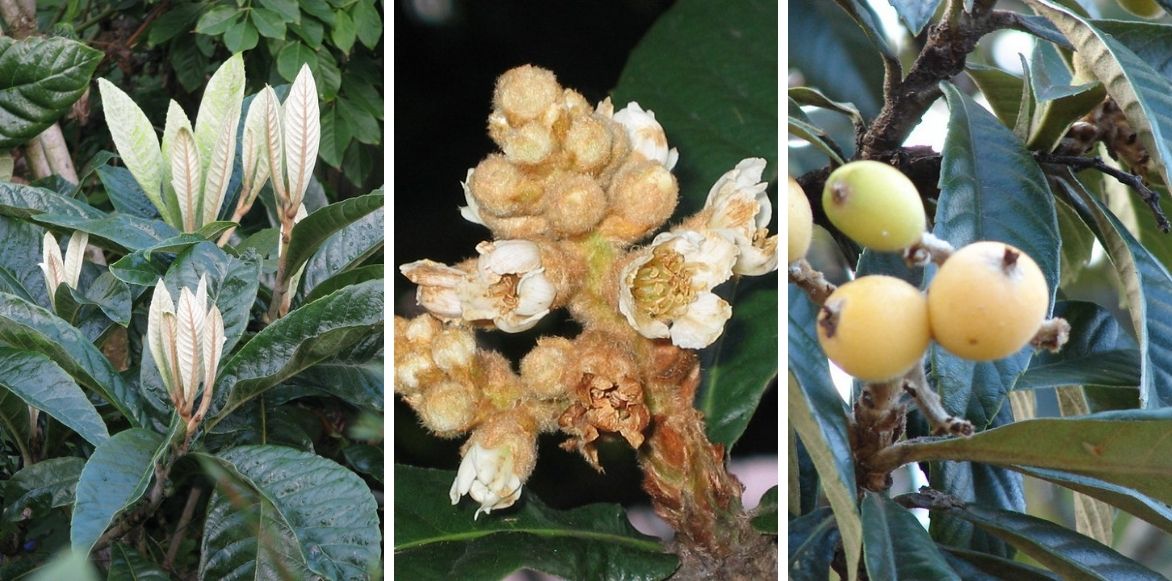
Foliage, flower buds, and fruits of Eriobotrya japonica
The silhouette of the Japanese loquat makes it a very decorative tree. Its foliage gives it a slight tropical tree appearance that will look stunning when isolated. If given a sunny location, especially well-sheltered from cold winds, against a wall for example, it will reward you with beautiful flowering and, above all, abundant fruiting.
Due to its origins, the Japanese loquat will thrive in southern and oceanic regions where it can withstand mild winters, especially not too cold, at the risk of seeing its fruiting become impossible. Elsewhere, it is quite possible to cultivate it in a pot, which should be brought indoors during winter to a non-heated, bright location like a conservatory.
It is a fruit tree that, in regions with mild winters, produces its fruits at a time when they are rare, similar to citrus trees. However, in pots, fruiting remains rare. It is cultivated as a small ornamental tree with undeniable charm, a graphic habit, and an original appearance.
The main varieties
Starting from the type species Eriobotrya japonica, numerous cultivars have been developed over the decades around the world. All originate from two specific sources: China and Japan, which produce Chinese loquats and others of Japanese origin. These two varieties are primarily distinguished by their fruits, which are either early or late.
Thus, the fruits of Chinese loquats are mid-season or late. They are generally very fragrant but less juicy.
Eriobotrya japonica ‘Tanaka’ is the most common, featuring firm-fleshed fruits, while Eriobotrya japonica ‘Gold Nugget’ offers late fruits with an apricot flavour.
The fruits of Japanese loquats are earlier and much juicier. The ‘Champagne’ variety is the most widespread in our gardens. Vigorous, it produces large yellow fruits. Eriobotrya japonica ‘Early Red’ has more reddish-orange fruits that are very sweet.
There is also a more ornamental hybrid variety, the Rhaphiobotrya ‘Coppertone’. Its young shoots resemble photinia, and its flowering is generous, coloured in pale pink, just like its fruiting. A bushy shrub worth discovering.
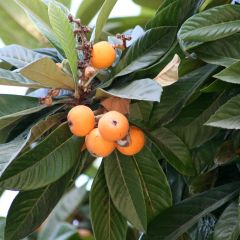
Eriobotrya japonica
- Flowering time November, December
- Height at maturity 6 m
Discover other Medlar trees
View all →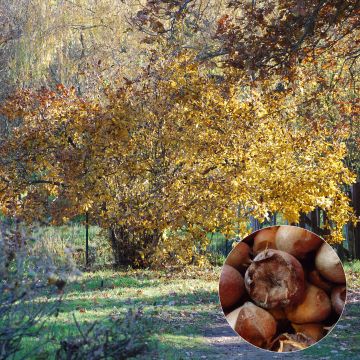
Available in 1 sizes
Available in 2 sizes
Available in 5 sizes
Available in 1 sizes
Available in 1 sizes
Available in 1 sizes
Available in 1 sizes
Available in 1 sizes
Available in 1 sizes
Planting the Japanese medlar
Where to plant the Japanese medlar?
The Japanese medlar is sensitive to light frosts, so it is essential to plant it in a location that receives very good sunlight. Similarly, a well-sheltered spot, such as along a wall, is recommended. In the Mediterranean region, it can tolerate a semi-shaded position. Generally, the Japanese medlar should not be planted in open ground north of the Loire, especially not at altitude or in the eastern regions of France. However, in the Mediterranean and oceanic areas, it does not particularly appreciate sea spray but can withstand drought.
Regarding the soil, the Japanese medlar requires well-drained, deep, and loose soil, which is rather rich and cool, without being waterlogged. It can adapt to dry, calcareous, or sandy soils but does not like rocky soils. It also accepts neutral or alkaline soils but prefers acidic soils. It develops a strong but poorly ramified root system, making it compact.
In a pot, provide a mixture of garden soil and potting compost. Be sure to include a layer of gravel at the bottom of the pot to facilitate drainage. A pot as large as possible, at least 50 cm in diameter, is preferable, but due to its rapid growth, the container may become too small after a few years. The pot should be placed in a sheltered and sunny location. In winter, the pot should be moved to an unheated room.
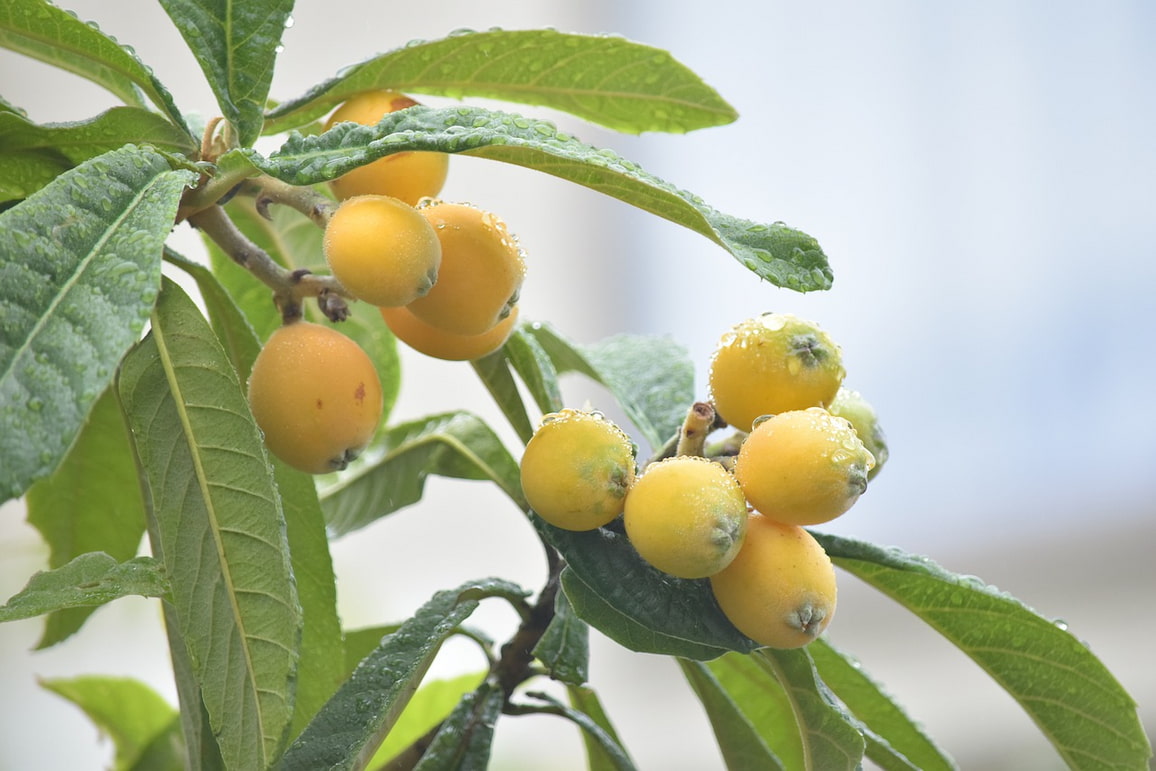 Grown in a pot, the Japanese medlar rarely fruits
Grown in a pot, the Japanese medlar rarely fruits
When to plant?
The best time to plant the Japanese medlar is at the end of summer, in September-October in regions with a warm climate. However, it is also possible to plant in spring, particularly in March for areas at the edge of hardiness.
How to plant?
- Dig a wide hole at least 40 to 60 cm in width and depth.
- Enrich the soil with well-matured compost or potting soil.
- Place the Japanese medlar in the hole, ensuring not to bury the collar.
- Backfill the hole, firm it down, and water generously.
- Staking is essential as the Japanese medlar has a strong wind resistance.
In a hedge, allow one plant per m².
Maintenance, pruning and care
Japanese medlar requires no special care apart from regular watering during the first two years after planting, especially in dry soils. After that, once it is well established, watering is not necessary except during dry spells.
However, in pots, the Japanese medlar should be watered regularly. Allow the soil to dry out between waterings.
A compost application in spring is beneficial to improve its foliage.
Pruning is not obligatory but can be carried out to thin the plant, remove dead branches, and aerate the crown by removing branches that grow towards the centre. This pruning takes place just after fruiting, in early summer. It should be gentle and light. → Learn more about pruning medlars with Pascale’s advice.
In winter, young plants can be covered with fleece to protect them from light frosts.
Pests and potential diseases
The Japanese medlar can be sensitive to pests and diseases. It may be attacked by aphids, scale insects, or fruit flies. While the former can be easily eradicated with black soap, the fruit fly is difficult to dislodge.
Scab, which is recognised by brown spots on the leaves, is treated with Bordeaux mixture applied once a month from January to April.
More serious is the attack of fire blight, which is highly virulent in certain regions on Rosaceae. Depending on the extent of the disease, one may simply cut and burn the affected branches or even the entire tree. In any case, it is obligatory to report a fire blight attack to the local council, which is indicated by the wilting of the leaves.
→ Learn more about diseases and pests of medlars in Pascale’s advice sheet.
Propagation of the Japanese Medlar
Multiplication by sowing is the simplest method, but you can also propagate by cuttings, use layering, or graft.
Sowing
In spring, collect stones just after harvesting the fruits. Bury them a few centimetres deep in a substrate and place them outside. Keep the substrate moist. You will easily obtain a young plant of loquat, but you will need to wait at least 8 years before it bears fruit.
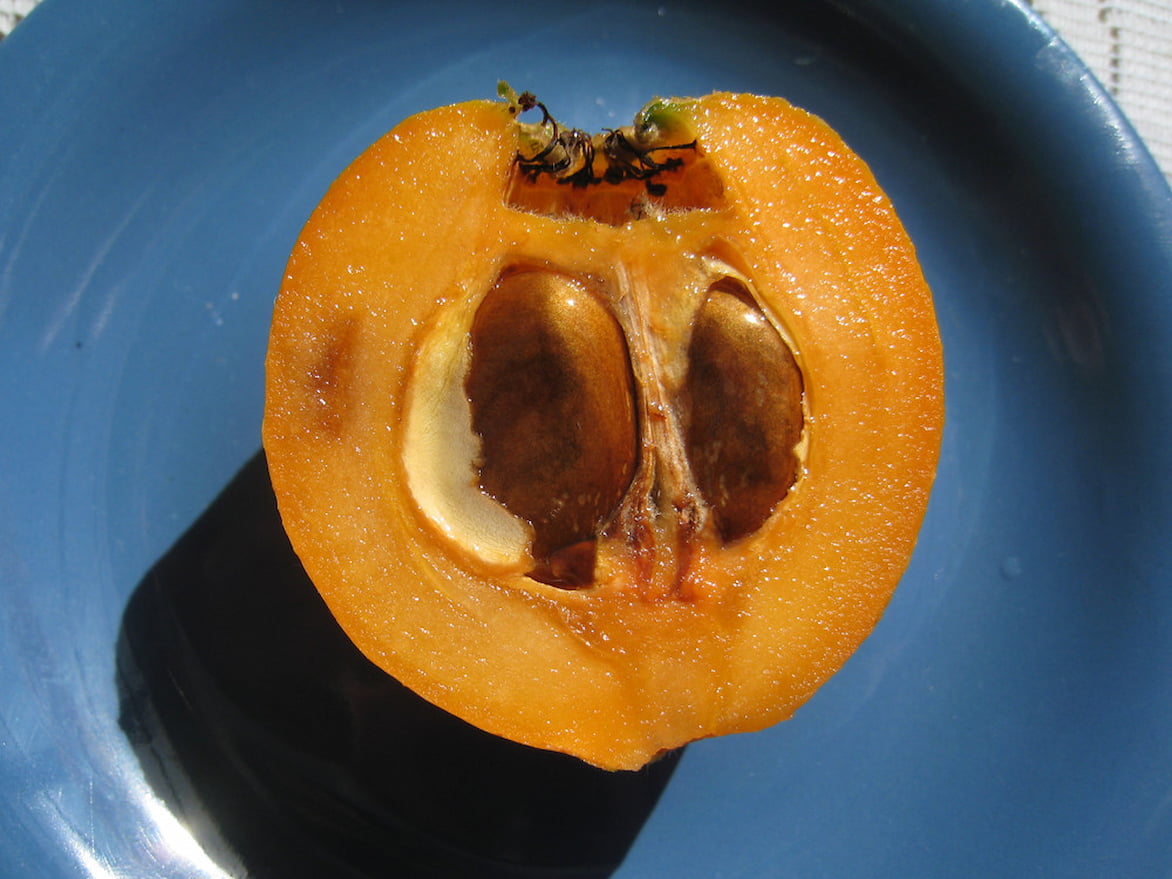
- Sowing Japanese loquat is quite simple, provided you plant the stone immediately after collection. You will need to wait at least 8 years for the tree to bear fruit.
Propagation by Cuttings
This is done in early summer, during June and July. The steps to follow are:
- Cut the tip of a non-flowering branch about 15 cm long.
- Remove the leaves from the lower half of the cutting.
- Prepare a mixture of cutting compost and sand, and plant the cutting halfway, up to the leaves.
- Water regularly by misting.
- When new leaves appear, pot your cuttings in pots and winter them in a frost-free, bright location.
- In spring, the young plants can be planted in the ground.
Layering
This multiplication technique is slow but works quite well for Japanese loquat. It involves bending a branch down to the ground to root it.
- At the end of summer, select a flexible branch that naturally bends towards the ground.
- Remove the leaves and scrape the bark for 5 to 10 cm if it is a bit thick, using a small knife or pruning shear.
- Burrow the branch about 10 cm deep and firm the soil.
- Secure the layering with two metal hooks.
- Support the aerial end of the branch.
- Water and be patient.
- The following spring, the layering can be separated from the mother plant and potted in the ground.
Grafting
Reserved for experienced gardeners, grafting is done in August or spring on a rootstock such as hawthorn, quince, common loquat, or pyracantha. Fruiting occurs after 5 years.
What to pair with the Japanese medlar?
The Japanese medlar is remarkable for its glossy green foliage, its spreading crown habit, and its fruiting, which varies from yellow to orange. As such, it is ideal as a standalone specimen, along a wall, or at the corner of two walls that protect it from winds and cold. It also takes on its full stature at the centre of a lawn in regions with very mild winters. In these conditions, it is difficult to associate the Japanese medlar with other plants due to its strong personality.
However, you can plant groundcover plants at its base, such as periwinkles, hardy geraniums nodosum, or Lamium maculatum.
-
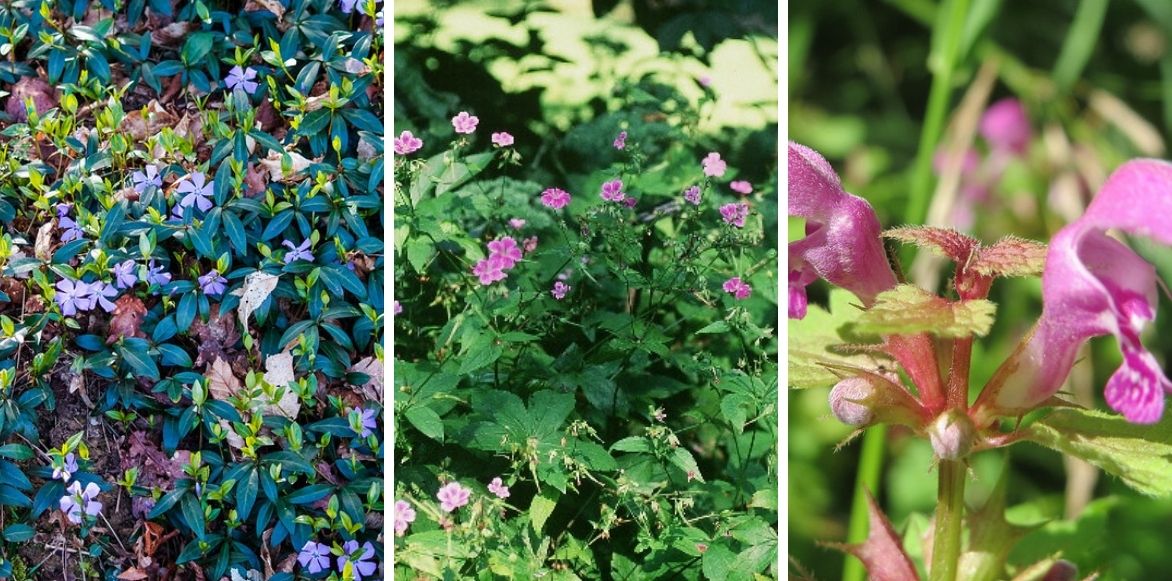 Periwinkles, hardy geraniums nodosum, and Lamium maculatum create lovely groundcover beneath a Japanese medlar
Periwinkles, hardy geraniums nodosum, and Lamium maculatum create lovely groundcover beneath a Japanese medlar
The flowering tones of lantanas also pair beautifully with the orange of the Japanese medlar’s fruits.
For an exotic atmosphere in areas with very mild winters, you can also create a plant tableau consisting of Euphorbia mellifera, Astelia, Canna indica Purpurea, and Pittosporum tobira.
-
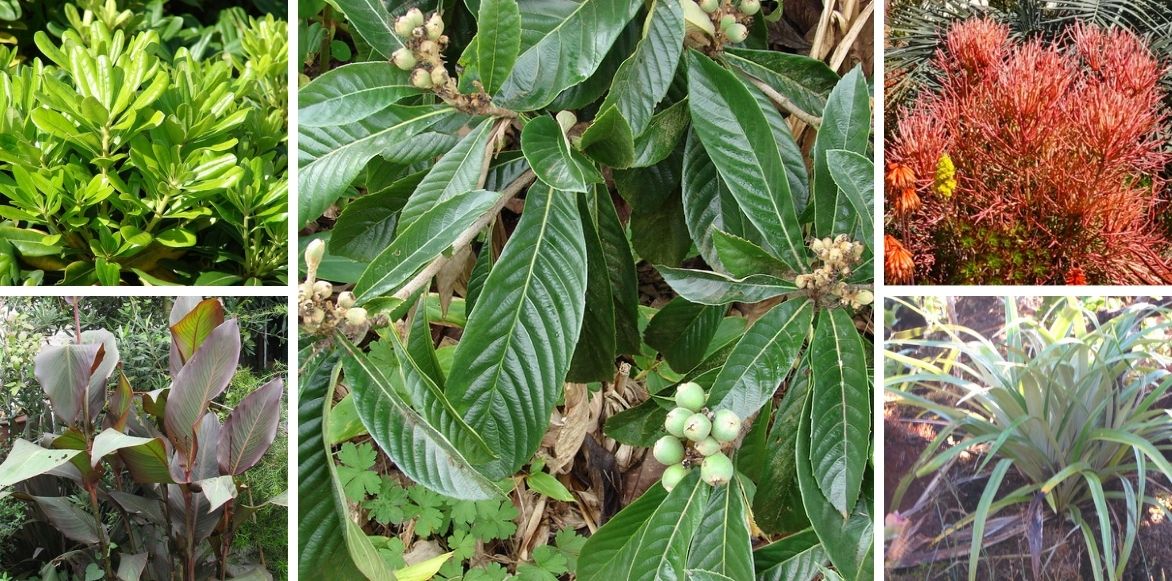 Euphorbia mellifera, Astelia, Canna indica Purpurea, and Pittosporum tobira create an exotic tableau with the Japanese medlar
Euphorbia mellifera, Astelia, Canna indica Purpurea, and Pittosporum tobira create an exotic tableau with the Japanese medlar
The Eriobotrya japonica will also look stunning alongside a Crinodendron.
Bibasses, fruits to discover
Traditionally used in Chinese medicine, the fruit of the Japanese medlar is packed with numerous medicinal virtues. It is recognised for its diuretic and laxative properties due to its high fibre content. It also possesses antioxidant, healing, antimicrobial, and anti-inflammatory effects found in both the fruit and the dried leaves consumed as tea or in decoction. The bibasse is also a fruit rich in vitamins A, C, B6, and B9, as well as minerals and trace elements. In short, eating bibasses can be beneficial for health and well-being.
But it is also a treat, as it is a sweet, juicy fruit. It is particularly popular in Réunion, eaten raw, or in fruit salads, jams, marmalades, or compotes, and puréed in pastries like bavarois or tarts. Its seeds, which are toxic, are also used in the making of arranged rums or a liqueur simply called bibasse, as they impart a slight almond flavour due to the presence of cyanide. Bibasse is also prepared in rougail or chutney to accompany curries, achards, or even meat dishes.
Useful resources
- Be captivated by an astonishing loquat that isn’t really one: the Rhaphiobotrya Coppertone
- Discover our wide selection of Mediterranean fruit trees
- Stock up on vitamins and sunshine with our fruit trees that smell of the south
- Advice sheet: Why isn’t my Japanese loquat fruiting?
- Did you know that loquat leaves can also be used for infusions? Read our article: “ How to make Japanese loquat tea? “.
- Subscribe!
- Contents
































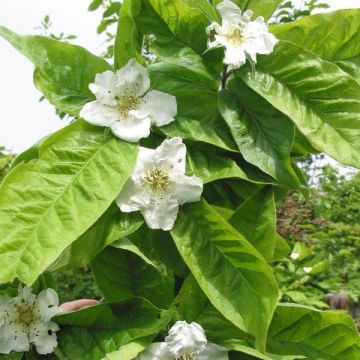
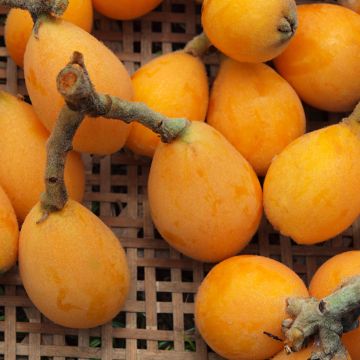
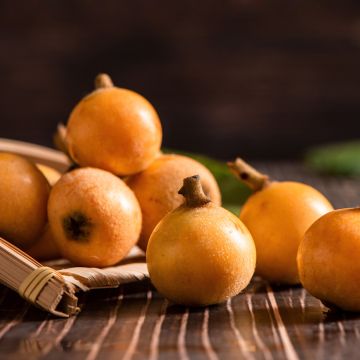
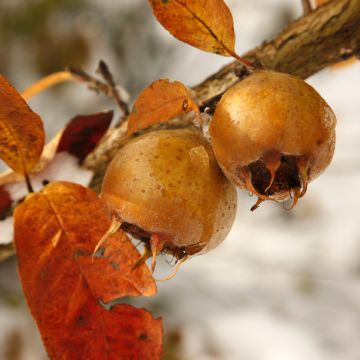
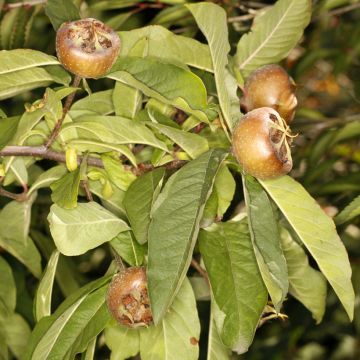
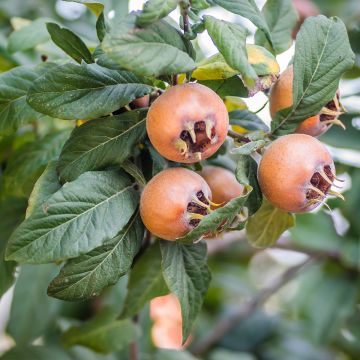
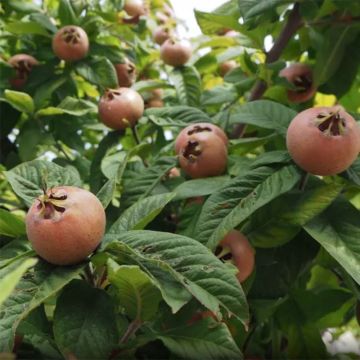
Comments